Financing Innovations for the Renewable Energy Transition in Europe
Abstract
:1. Introduction
- How much energy R&D funding will be provided by the EU MS, and the EC between the present and 2030?
- Are RES sources funded equally?
- Are the EU MS and EC energy knowledge stocks different?
2. Materials and Methods
2.1. Energy R&D of the EU MS and the EC
2.2. Scenarios of Public R&D Expenditures until 2030
2.3. Cumulative RES Knowledge Stock
2.4. Literature Review and Discussion of the Method
3. Results
3.1. Annual Energy R&D Expenditures
3.1.1. European Union MS
3.1.2. European Commission
3.2. The Cumulative RES Knowledge Stock
3.2.1. European Union MS
3.2.2. European Commission
3.2.3. Cumulative Knowledge Stock (Considering Both EU and MS)
4. Discussion and Conclusions
Acknowledgments
Author Contributions
Conflicts of Interest
References
- Dinan, D. Europe Recast: A History of European Union; Lynne Rienner Publishers: Boulder, CO, USA, 2015. [Google Scholar]
- Research & Innovation. Energy. Available online: http://ec.europa.eu/research/energy/euratom/index_en.cfm?pg=fission§ion=history (accessed on 7 September 2016).
- El-Agraa, A.M. The European Union: Economics and Policies; Cambridge University Press: Cambridge, UK, 2011. [Google Scholar]
- Energy Production and Imports. Available online: http://ec.europa.eu/eurostat/statistics-explained/index.php?title=Energy_production_and_imports&oldid=299321 (accessed on 8 September 2016).
- EU Member States Not Reaching 2020 Energy Efficiency Goals. Commission Says. Available online: http://www.euractiv.com/section/energy/news/eu-member-states-not-reaching-2020-energy-efficiency-goals-commission-says/ (accessed on 8 September 2016).
- Energy. 2030 Energy Strategy. Available online: https://ec.europa.eu/energy/en/topics/energy-strategy/2030-energy-strategy (accessed on 19 September 2016).
- Energy Roadmap 2050. Available online: https://ec.europa.eu/energy/sites/ener/files/documents/2012_energy_roadmap_2050_en_0.pdf (accessed on 10 September 2016).
- What Is the SET-Plan? Available online: https://setis.ec.europa.eu/about-setis/set-plan-governance (accessed on 11 September 2016).
- Data Services. Available online: http://wds.iea.org/WDS/Common/Login/login.aspx (accessed on 1 June 2016).
- Research & Innovation. Energy. Available online: http://ec.europa.eu/research/energy/eu/index_en.cfm?pg=projects#projects (accessed on 1 June 2016).
- Fifth Framework Programme. Available online: http://cordis.europa.eu/fp5/src/budget.htm. (accessed on 2 June 2016).
- Research & Innovation. Sixth Framework Programme 2002–2006. Available online: https://ec.europa.eu/research/fp6/index_en.cfm (accessed on 2 June 2016).
- Research & Innovation. FP7. Available online: https://ec.europa.eu/research/fp7/index_en.cfm (accessed on 4 June 2016).
- Research & Innovation. FP7 in Brief. Available online: http://ec.europa.eu/research/fp7/understanding/fp7inbrief/home_en.html (accessed on 4 June 2016).
- Horizon 2020. The EU Framework Programme for Research and Innovation. Available online: https://ec.europa.eu/programmes/horizon2020/ (accessed on 6 June 2016).
- R&D Expenditure. Available online: http://ec.europa.eu/eurostat/statistics-explained/index.php/R_%26_D_expenditure (accessed on 7 June 2016).
- Community Research and Development Information Service (CORDIS). Available online: http://cordis.europa.eu/projects/home_en.html (accessed on 8 June 2016).
- European Commission. Council Decision of 25 January 1999 adopting a specific programme for research, technological development and demonstration on energy environment and sustainable development (1998 to 2002). Off. J. Eur. Communities 1999, 12, 20–64. [Google Scholar]
- Divaldalbero, D. The Power of Science: Economic Research and European Decision-Making: The Case of Energy and Environment Policies; Peter Lang Publishing: New York, NY, USA, 2010. [Google Scholar]
- Europe 2020 Indicators—Research and Development. Available online: http://ec.europa.eu/eurostat/statistics-explained/index.php/Europe_2020_indicators_-_research_and_development (accessed on 8 June 2016).
- What Is the Sixth Framework Programme? Available online: https://ec.europa.eu/research/fp6/index_en.cfm (accessed on 9 June 2016).
- Overview of EU Funds for Research and Innovation. Available online: http://www.europarl.europa.eu/RegData/etudes/BRIE/2015/568327/EPRS_BRI(2015)568327_EN.pdf (accessed on 10 June 2016).
- GDP Long-Term Forecast. Available online: https://data.oecd.org/gdp/gdp-long-term-forecast.htm (accessed on 13 June 2016).
- Baccini, L.; Urpelainen, J. Legislative fractionalization and partisan shifts to the left increase the volatility of public energy R&D expenditures. Energy Policy 2012, 46, 49–57. [Google Scholar]
- Bointner, R.; Pezzutto, S.; Sparber, W. Scenarios of public energy research and development expenditures: Financing energy innovation in Europe. WIREs Energy Environ. 2016, 5, 470–488. [Google Scholar] [CrossRef]
- Exchange Rates. Available online: http://ec.europa.eu/eurostat/web/exchange-rates (accessed on 15 June 2016).
- Member Participation. Available online: http://mission-innovation.net/participating-countries/#EuropeanUnion (accessed on 16 June 2016).
- Mission Innovation. Accelerating the Clean Energy Revolution. Available online: http://mission-innovation.net/ (accessed on 16 June 2016).
- Klaassen, G.; Miketa, A.; Larsen, K.; Sundqvist, T. The impact of R&D on innovation for wind energy in Denmark, Germany and the United Kingdom. Ecol. Econ. 2005, 54, 227–240. [Google Scholar]
- Kobos, P.H.; Erickson, J.D.; Drennen, T.E. Technological learning and renewable energy costs: Implications for US renewable energy policy. Energy Policy 2006, 34, 1645–1658. [Google Scholar] [CrossRef]
- Bointner, R. Innovation in the energy sector: Lessons learnt from R&D expenditures and patents in selected IEA countries. Energy Policy 2014, 73, 733–747. [Google Scholar]
- Energieforschungserhebung 2011—Ausgaben der öffentlichen Hand in Österreich. Erhebung für die IEA im Auftrag des Bundesministeriums für Verkehr, Innovation und Technologie. Available online: https://nachhaltigwirtschaften.at/resources/iea_pdf/1255_energieforschungserhebung_2011.pdf?m=1469660095/ (accessed on 20 September 2016).
- Wiesenthal, T.; Leduc, G.; Haegeman, K.; Schwarz, H. Bottom-up estimation of industrial and public R&D investment by technology in support of policymaking: The case of selected low-carbon energy technologies. Res. Policy 2012, 41, 116–131. [Google Scholar]
- Johnstone, N.; Haščič, I.; Popp, D. Renewable Energy Policies and Technological Innovation: Evidence Based on Patent Counts. Environ. Resour. Econ. 2009, 45, 133–155. [Google Scholar] [CrossRef]
- Popp, D. Innovation in climate policy models: Implementing lessons from the economics of R&D. Energy Econ. 2006, 28, 596–609. [Google Scholar]
- Gallaher, M.P.; Link, A.N.; O’Connor, A. Public Investments in Energy Technology; Edward Elgar Publishing: Northampton, MA, USA, 2012. [Google Scholar]
- Watanabe, C.; Wakabayashi, K. Industrial dynamism and the creation of a ‘virtuous cycle’ between R&D, market growth and price reduction: The case of photovoltaic power generation (PV) development in Japan. Technovation 2000, 20, 299–312. [Google Scholar]
- Miketa, A.; Schrattenholzer, L. Experiments with a methodology to model the role of R&D expenditures in energy technology learning processes; first results. Energy Policy 2004, 32, 1679–1692. [Google Scholar]
- IEA Guide to Reporting Energy RD&D Budget/Expenditure Statistics. Available online: www.iea.org/stats/RDD%20Manual.pdf (accessed on 5 November 2016).
- Kusre, B.C.; Baruah, D.C.; Bordoloi, P.K.; Patra, S.C. Assessment of hydropower potential using GIS and hydrological modeling technique in Kopili River basin in Assam (India). Appl. Energy 2010, 87, 298–309. [Google Scholar] [CrossRef]
- Barbier, E. Geothermal energy technology and current status: An overview. Renew. Sustain. Energy Rev. 2002, 6, 3–65. [Google Scholar] [CrossRef]
- Simas, T.; O’Hagan, A.M.; O’Callaghan, J.; Hamawi, S.; Magagna, D.; Bailey, I.; Greaves, D.; Saulnier, J.-B.; Marina, D.; Bald, J.; et al. Review of consenting processes for ocean energy in selected European Union Member States. Int. J. Mar. Energy 2015, 9, 41–59. [Google Scholar] [CrossRef]
- Development of a Tool to Model European Biomass Trade Report for IEA Bioenergy Task 40. Available online: http://www.bioenergytrade.org/downloads/development-of-a-tool-to-model-european-biomas.pdf (accessed on 17 September 2016).
- Grilli, G.; De Meo, I.; Garegnani, G.; Paletto, A. A multi-criteria framework to assess the sustainability of renewable energy development in the Alps. J. Environ. Plan. Manag. 2016. [Google Scholar] [CrossRef]
- Sharman, A.; Holmes, J. Evidence-based policy or policy-based evidence gathering? Biofuels, the EU and the 10% target. Environ. Policy Gov. 2010, 20, 309–321. [Google Scholar] [CrossRef]
- Belkin, P. The European Union’s Energy Security Challenges; Congressional Research Service: Washington, DC, USA, 2008.
- Brutschin, E.; Fleig, A. Innovation in the energy sector—The role of fossil fuels and developing economies. Energy Policy 2016, 97, 27–38. [Google Scholar] [CrossRef]
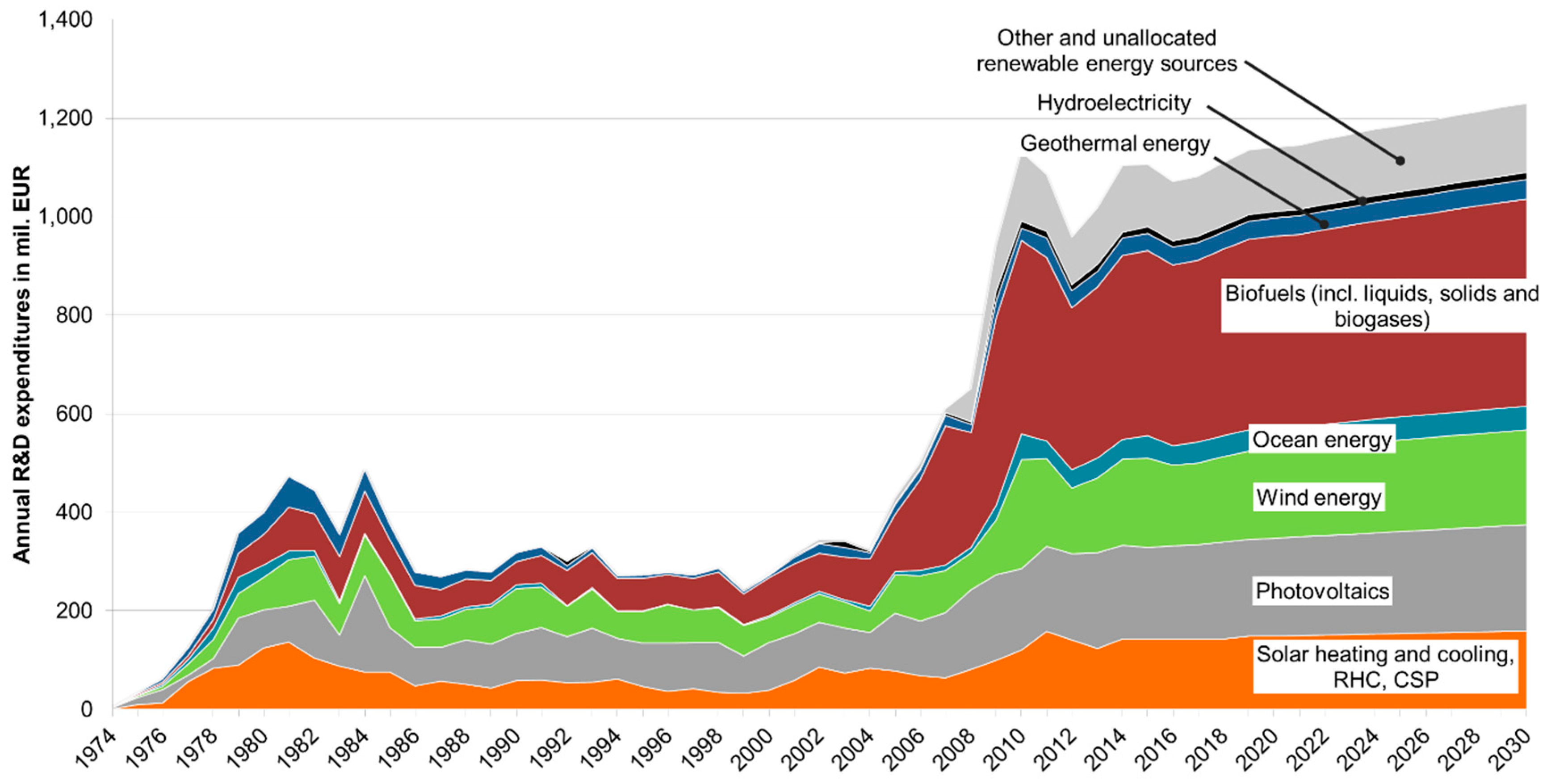

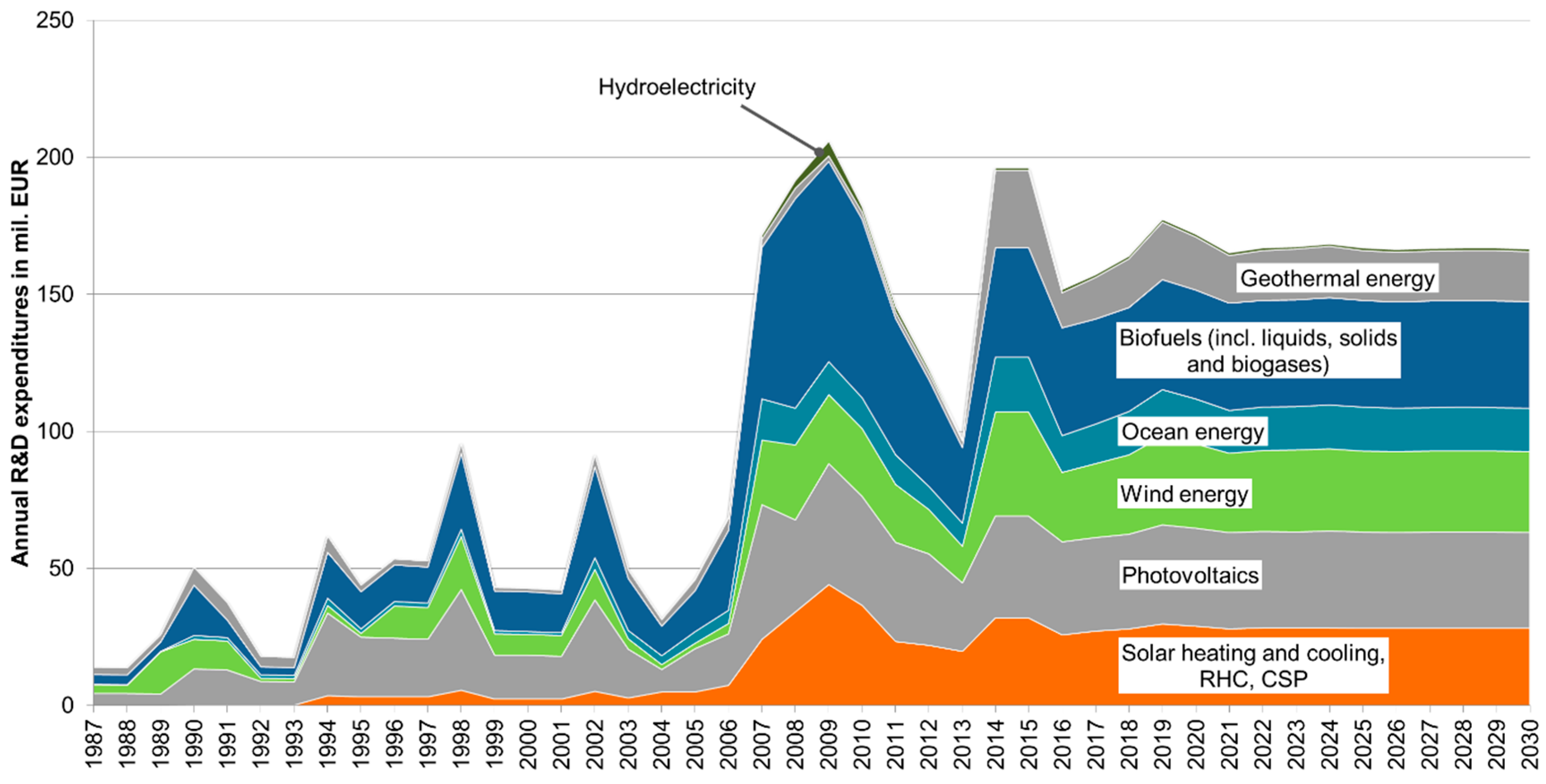
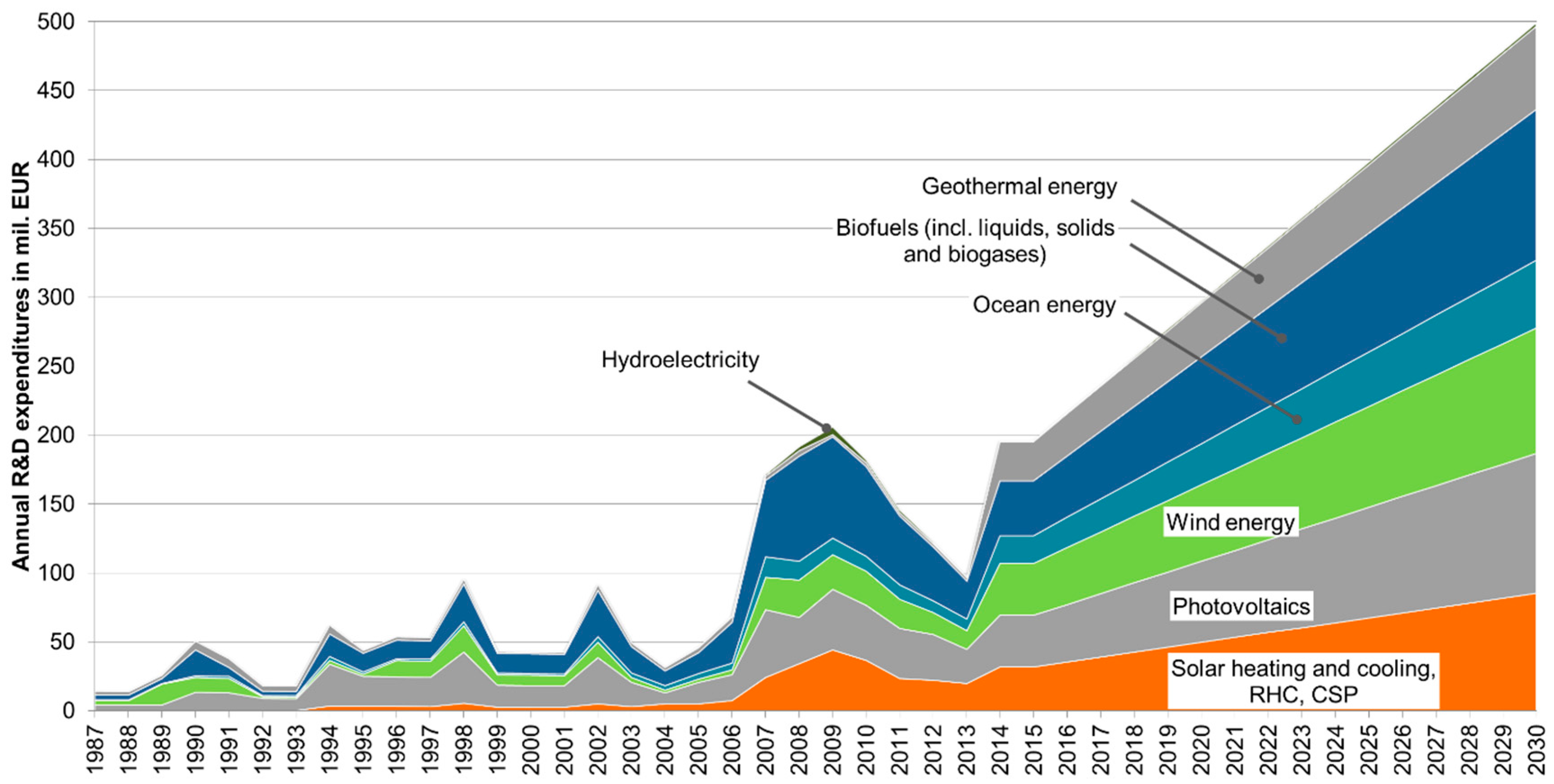
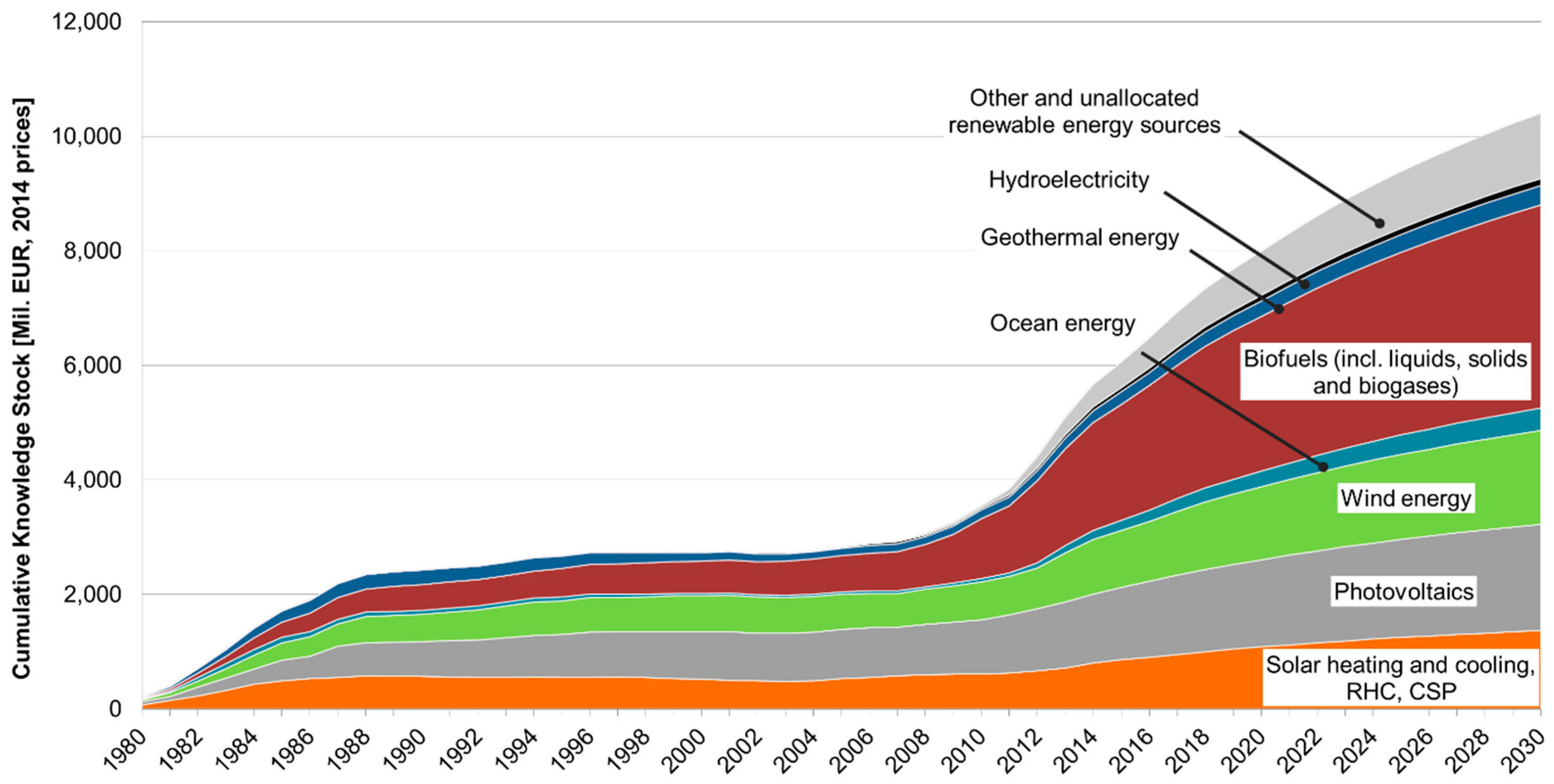

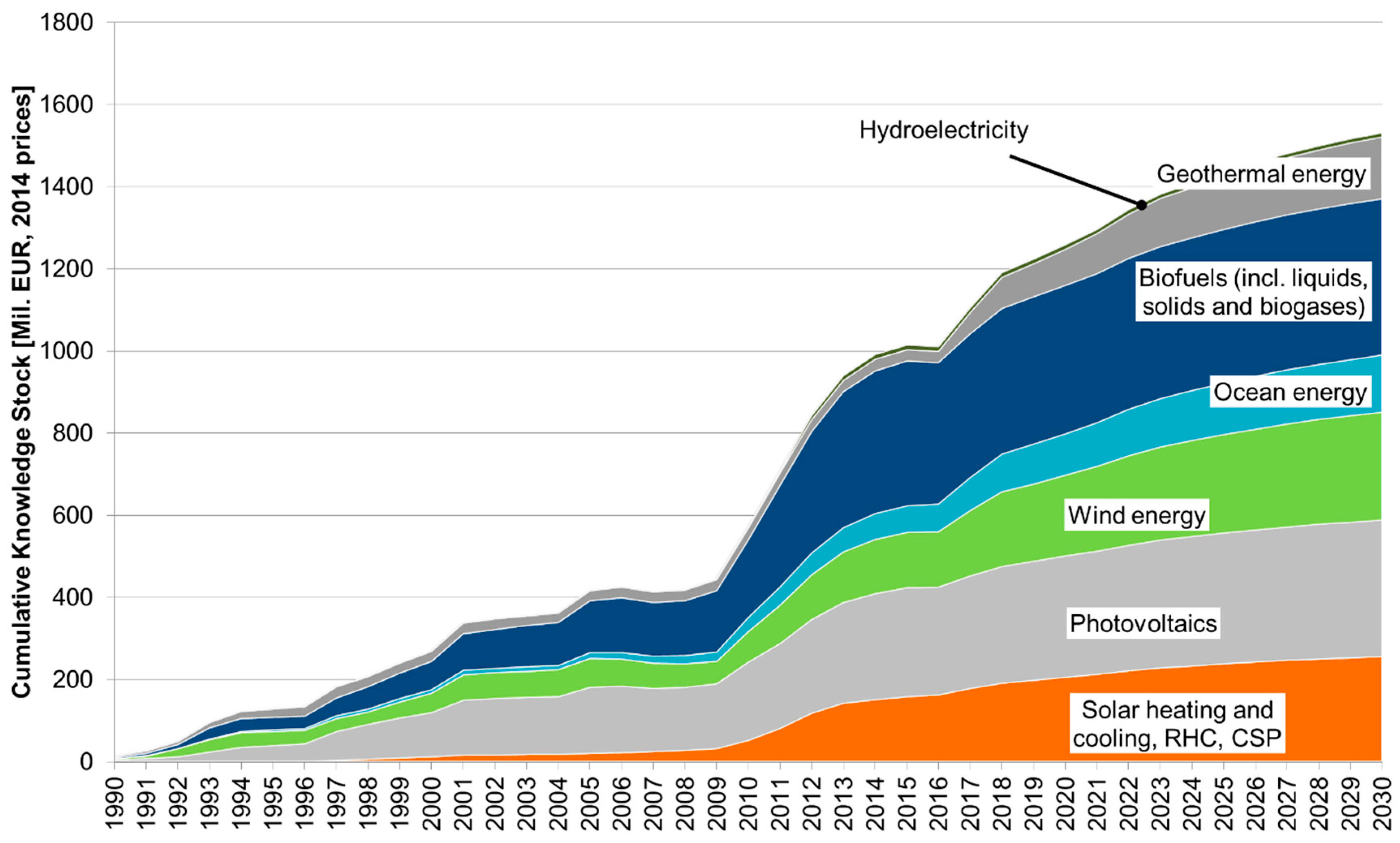
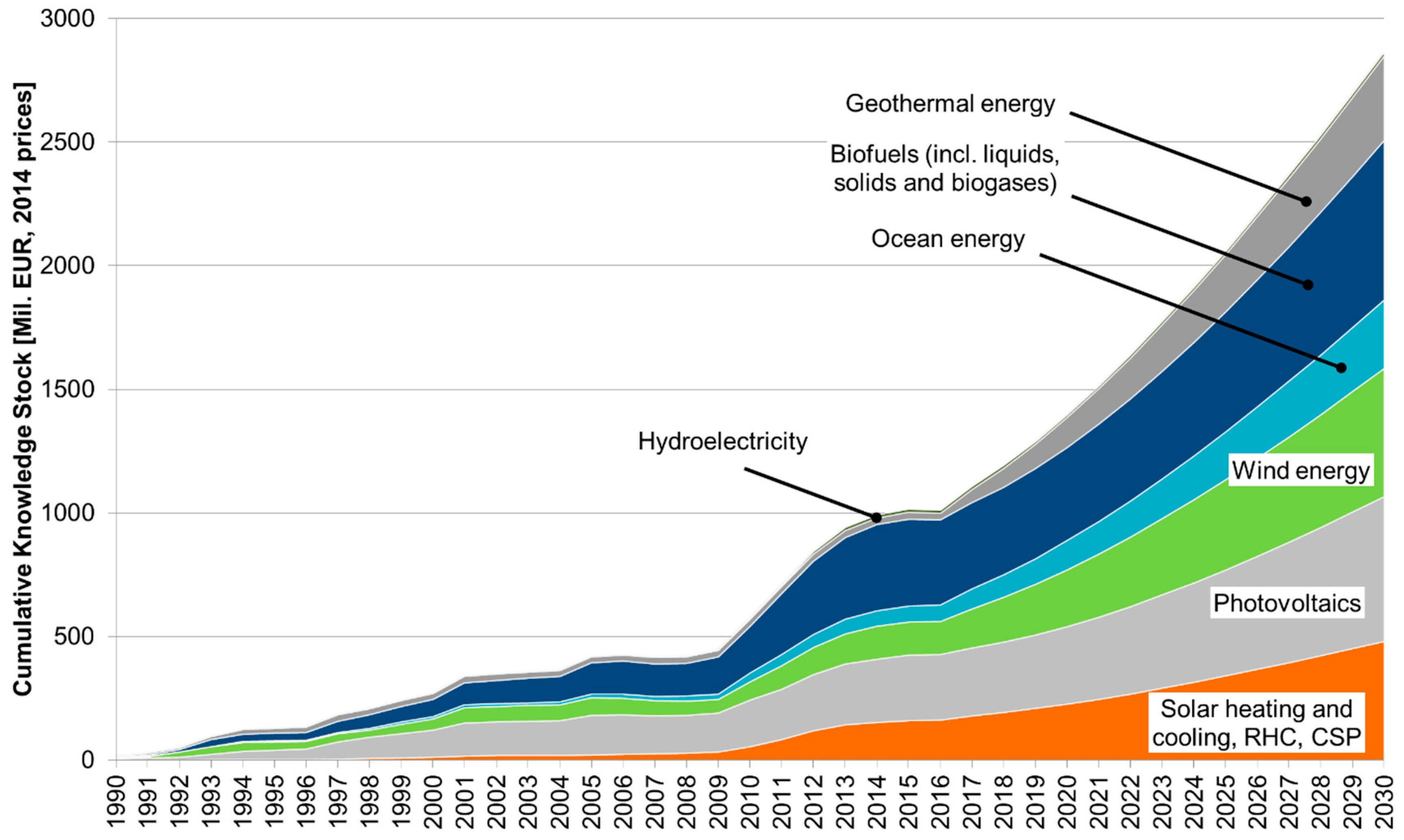

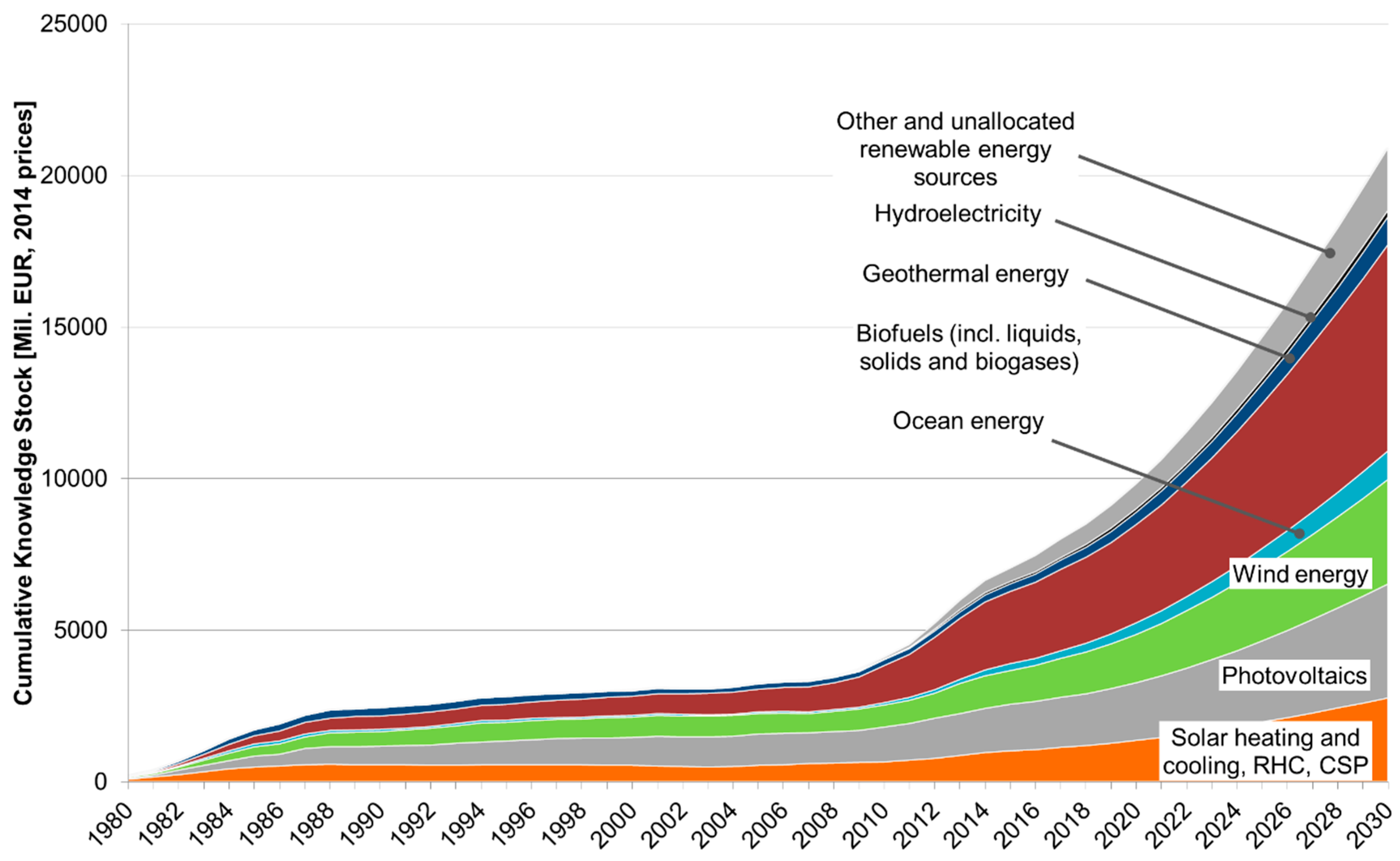
| EU and IEA Members | Non-IEA EU MS |
|---|---|
| Austria, Belgium, Czech Republic, Denmark, Estonia, Finland, France, Germany, Greece, Hungary, Ireland, Italy, Luxemburg, Netherlands, Poland, Portugal, Slovakia, Spain, Sweden and United Kingdom | Bulgaria, Croatia, Cyprus, Latvia, Lithuania, Malta, Romania and Slovenia |
| 2010 | 2015 | 2020 | 2025 | 2030 | |
|---|---|---|---|---|---|
| Austria | 294.6 | 337.2 | 389.1 | 436.2 | 480.0 |
| Belgium | 365.1 | 409.8 | 466.1 | 525.2 | 587.7 |
| Czech Republic | 156.4 | 164.0 | 182.2 | 216.6 | 247.8 |
| Denmark | 241.5 | 266.1 | 320.9 | 375.6 | 430.5 |
| Estonia | 14.7 | 20.5 | 27.1 | 31.2 | 34.9 |
| Finland | 187.1 | 207.0 | 239.4 | 266.0 | 293.9 |
| France | 1998.5 | 2182.3 | 2474.8 | 2831.0 | 3176.9 |
| Germany | 2580.1 | 3025.9 | 3493.6 | 3962.8 | 4431.7 |
| Greece | 226.0 | 176.0 | 205.7 | 231.3 | 263.1 |
| Hungary | 98.2 | 108.7 | 133.7 | 152.2 | 167.9 |
| Ireland | 166.2 | 214.6 | 272.7 | 336.3 | 386.2 |
| Italy | 1604.5 | 1636.4 | 1809.9 | 2045.7 | 2274.7 |
| Luxembourg | 39.5 | 51.8 | 66.0 | 80.0 | 94.3 |
| Netherlands | 631.5 | 665.5 | 781.1 | 904.9 | 1008.4 |
| Poland | 361.7 | 427.8 | 533.5 | 617.6 | 670.1 |
| Portugal | 179.9 | 179.4 | 205.5 | 229.3 | 253.2 |
| Slovakia | 67.4 | 78.1 | 97.8 | 127.5 | 141.6 |
| Spain | 1080.9 | 1081.2 | 1265.1 | 1372.0 | 1517.2 |
| Sweden | 369.1 | 444.2 | 550.7 | 647.8 | 726.4 |
| United Kingdom | 1813.3 | 2568.1 | 2812.3 | 3347.0 | 3795.8 |
© 2016 by the authors; licensee MDPI, Basel, Switzerland. This article is an open access article distributed under the terms and conditions of the Creative Commons Attribution (CC-BY) license (http://creativecommons.org/licenses/by/4.0/).
Share and Cite
Bointner, R.; Pezzutto, S.; Grilli, G.; Sparber, W. Financing Innovations for the Renewable Energy Transition in Europe. Energies 2016, 9, 990. https://doi.org/10.3390/en9120990
Bointner R, Pezzutto S, Grilli G, Sparber W. Financing Innovations for the Renewable Energy Transition in Europe. Energies. 2016; 9(12):990. https://doi.org/10.3390/en9120990
Chicago/Turabian StyleBointner, Raphael, Simon Pezzutto, Gianluca Grilli, and Wolfram Sparber. 2016. "Financing Innovations for the Renewable Energy Transition in Europe" Energies 9, no. 12: 990. https://doi.org/10.3390/en9120990
APA StyleBointner, R., Pezzutto, S., Grilli, G., & Sparber, W. (2016). Financing Innovations for the Renewable Energy Transition in Europe. Energies, 9(12), 990. https://doi.org/10.3390/en9120990







